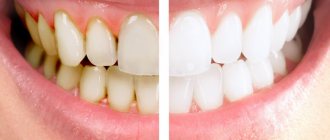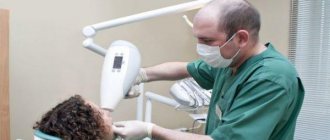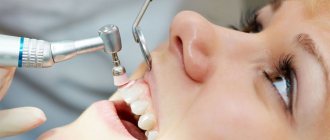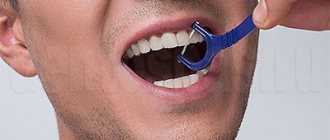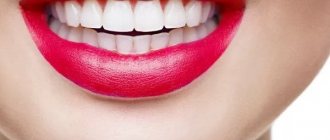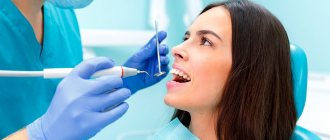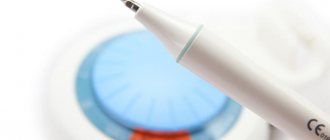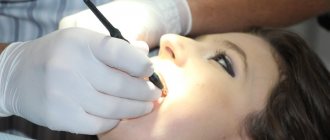What it is?
Professional teeth cleaning means removing hard and soft plaque from teeth, as well as polishing them. Therefore, the procedure usually consists of two parts, and various methods can be used to remove the stone, for example:
- mechanical;
- ultrasonic;
- laser:
- sandblasting (Air Flow);
- using the VECTOR device.
In serious cases, the dentist may use a combination of several methods. Most often, ultrasonic cleaning is done, and then for final polishing, Air Flow is used.
In addition to caring for your teeth, professional cleaning takes care of the condition of your fillings and polishes the filling material. This allows you to preserve the original color of the filling and prevent its destruction.
During the manipulation process, the dentist performs a hardware removal of all excess from the tooth enamel and removes particles from the oral cavity. At the end, a protective fluoride varnish is applied, which reduces tooth sensitivity and contributes to the long-term preservation of the light tone of the enamel and the smoothness of each tooth.
Effect of professional cleaning on dental restorations
AirFlow affects restorations in the same way as it does on your own teeth - it removes attached plaque and creates slight roughness. Ceramic and metal structures normally have a surface smoothness higher than the enamel of your own teeth. Plaque sticks to them much less often, and there is no need to treat them at all if there is no need. If, nevertheless, air-abrasive treatment of ceramic, metal-ceramic or metal crowns is required, then they should be polished not with a brush and toothpaste, but with a special polishing set.
Separate polishing agents are also used for fillings, plastic, composite or metal-plastic crowns. These materials are less smooth than tooth enamel, and therefore accumulate plaque faster. Grinding the outer layer of such restorations can slightly improve their appearance, since these materials themselves darken over time, and the darkening is most pronounced in the superficial areas. However, the painted border between the filling and the tooth is not always eliminated in this way.
Ultrasonic treatment can lead to the loss of low-quality restorations. Even if the filling looked good outwardly and did not create any problems, its loss during ultrasonic cleaning indicates that adhesion to the tooth has already decreased to its minimum values. After some short time, such a filling would fall out on its own. But a dentist will not remove a high-quality restoration with an ultrasound, even if he really wants to and spends the whole day working on it.
Metal ultrasonic attachments are used to clean teeth. Composite fillings can become stained upon contact (the resulting streaks can then be easily sanded off). Contact with a metal ultrasonic tip is contraindicated for ceramic restorations (crowns, inlays, onlays, bridges) as cracks may form. For their processing, special polymer ultrasonic tips are used that do not damage the ceramics. The same attachments are used when cleaning implants.
Rice. 6. Ultrasonic tip for implants and ceramic restorations.
Should I brush my teeth?
The question of whether it is worth having professional teeth cleaning or using home remedies may be of interest to almost every person. To understand the need for such a procedure, you should know how plaque is formed.
Even if you carefully follow your dentist’s recommendations and brush your teeth regularly, ideally after every meal, using a toothbrush and the best toothpaste can only remove soft plaque. And even with the correct movements and careful work of the brush, there may be hard-to-reach places in the dentition where, in a short period of time, plaque is mineralized by calcium salts, which are contained in human saliva. As a result, hard plaque (tartar) forms, which cannot be removed at home.
Tartar is made up of bacteria that cause serious dental disease and can lead to the loss of one or more teeth. In addition, the stone is dark in color, so teeth lose their natural whiteness with plaque.
The peculiarity of the formation of tartar is that as soon as the first film appears on the teeth, the process accelerates significantly. The surface of the tooth enamel becomes rough, so various microorganisms easily stick to it. In addition to losing a beautiful appearance, a person develops bad breath.
To get rid of tartar and restore natural whiteness, you need to have your teeth cleaned in a clinic. Only a specialist with dental equipment can effectively remove plaque and tartar, polish and subsequently care for teeth.
Harm
- Subgingival calculus removal can be a painful procedure, especially if the patient has severe plaque buildup. However, in the conditions of modern medicine, this issue is resolved by the use of anesthesia. In 98% of cases, the procedure takes place without anesthesia, and only in 2% of cases, with hypersensitivity to pain, anesthesia is used.
- During the procedure for removing tartar, damage to the gums occurs. This is an inevitable injury that is usually accompanied by bleeding and sometimes pain. These symptoms disappear within a few hours, and complete restoration of gum tissue occurs within a week.
- Professional ultrasonic teeth cleaning can cause fillings to fall out. However, the loss of the restoration indicates poor quality of its adhesion to the tooth. A timely detected defect in the seal-tooth seal prevents the development of hidden pathological processes. A filling that fits well to a tooth cannot be removed with ultrasound.
- Professional teeth cleaning with ultrasound has a number of contraindications. These include severe diseases of the cardiovascular system, as well as bronchitis and asthma, serious infectious diseases (hepatitis and tuberculosis), wearing a pacemaker, the presence of implants or orthopedic structures in the mouth, childhood and adolescence. In all cases where ultrasound cannot be used, an alternative is used - Air Flow abrasive cleaning.
To avoid or minimize the negative consequences of professional teeth cleaning, be sure to choose professionals with a proven reputation!
Make an appointment for an examination and consultation with the dentists at the VOKA clinic before the procedure.
How often should I clean?
Dentists have a unanimous opinion on the issue of frequency of teeth cleaning. The procedure should be performed 1-2 times a year, but not more often, so as not to damage the enamel.
It is necessary to take into account the individual characteristics of the body - for some it is enough to clean the stone once a year, while for another person plaque formation occurs faster, and he needs to visit the dental clinic once every six months.
In addition, professional teeth cleaning is indicated before prosthetics, implantation and dental treatment, as well as before teeth whitening. A clean tooth surface will allow the dentist to do his job better:
- better choose the color of the filling, crown or veneer;
- notice the onset of caries in time;
- prevent many gum diseases;
- achieve good treatment and whitening results.
This manipulation is recommended for those people who smoke and often drink drinks with dyes (tea, coffee, wine, etc.).
Benefit
Contrary to popular belief, there is currently no evidence of the usefulness of occupational hygiene in preventing caries.
But professional cleaning is a good prevention of periodontitis. Moreover, for gingivitis and mild forms of periodontitis, it may be the only treatment method. By eliminating tartar, inflammation of the marginal gums is relieved - thus the periodontal condition is normalized, and other methods of treatment are not required.
Removing supragingival dark pigmented plaque improves appearance. Sometimes even professional hygiene is confused with bleaching. When whitening, the structure of tooth tissue changes chemically; when brushing, it only removes plaque adhering to the surface (the color of the teeth itself does not change, but visually they look lighter than with dark plaque).
Cleaning methods
Currently, dentists offer several methods for cleaning teeth. The oldest is mechanical, when tartar is destroyed using a special tool in the form of hooks. This method can injure your gums, so it is rarely used.
One of the progressive methods is ultrasound. Cleansing is carried out using an ultrasonic scaler. Stones are destroyed by sound vibrations of a certain frequency, while plaque is removed and supragingival and subgingival pockets are cleaned. The doctor can use attachments of different sizes, depending on the complexity of the treatment area and the thickness of the plaque. In addition, during the work, water or an antiseptic is supplied to the oral cavity, which removes stone particles through a dental saliva ejector. The patient does not feel pain, but if the necks of the teeth are sensitive, the doctor administers local anesthesia.
Modern laser systems allow not only to remove the hardest tartar, but also to whiten teeth. The device causes the evaporation of moisture contained in plaque and removes deposits from the enamel in layers. At the same time, the enamel receives a lighter shade, and the achieved result of a snow-white smile will last for several years. The procedure is absolutely painless, but for certain categories of patients there are contraindications.
The latest Swiss technology Air Flow makes it possible to remove particles of plaque, stone and pigments in hard-to-reach places, clean subgingival pockets and polish enamel. Treatment is carried out with a jet of cleaning mixture, which consists of sodium bicarbonate and water. Under high pressure, this composition is applied to each tooth. Regular baking soda acts as an abrasive. This sandblasting method allows for high-quality hygienic treatment, removing all excess from the teeth, achieving a smooth surface of the tooth enamel and its natural lightening. The manipulation is painless and pleasant for the patient. The result is a Hollywood smile and clean teeth.
The VECTOR device is the latest word in dentistry. It is intended for the prevention and treatment of periodontitis and acts by vibration. This technique takes advantage of ultrasonic waves and the active action of a fluoride and calcium based cleaning mixture. Using such equipment, the doctor removes deposits and bacteria, cleans subgingival pockets and polishes tooth enamel.
Modern people have a wide choice of professional hygiene methods. A consultation with a dentist will help you choose the most suitable one.
Features of the Air Flow procedure
Air Flow is a sandblasting device made in Switzerland for removing soft bacterial plaque on teeth. It is used when dental plaque has not yet had time to harden and turn into stone.
The essence of the procedure
The abrasive mixture is delivered through a thin tip under high pressure. The paste consists of fine powdered sodium bicarbonate (soda), as well as water and air. A powerful jet hits the dental plaque, washing it away from the enamel. At the same time, the surface of the teeth is polished and ground, becoming smooth and shiny.
Air Flow is considered absolutely safe, since the soda crystals are very small and cannot damage teeth. However, if the enamel is too thin, sensitive and weakened, postpone the session until later.
The method is also used to prepare the tooth surface before aesthetic and medical procedures: whitening, fluoridation, installation of veneers, braces, so that the enamel is perfectly smooth and clean.
Before and after Air Flow cleaning
Indications and contraindications
Teeth cleaning in a dental clinic is recommended for everyone, but those people who:
- have installed permanent dental structures (braces, veneers, crowns, implants, etc.);
- are going to undergo professional teeth whitening;
- planning prosthetics or dental treatment;
- smoke;
- drink a lot of drinks that have a coloring effect (coffee, tea, etc.).
If there are certain health problems, a person cannot use any of the teeth cleaning methods offered by dentists, but if necessary, you can choose another option. For example, temporary contraindications include:
- inflammation of the oral mucosa;
- ARVI, bronchitis or other diseases that make nasal breathing difficult;
- pregnancy and breastfeeding period.
In such cases, professional teeth cleaning can be done after such reasons have ended.
General contraindications include the following health problems:
- arrhythmia and other heart diseases;
- asthma;
- increased sensitivity of teeth;
- allergic reactions;
- tuberculosis;
- hepatitis;
- various infectious diseases;
- epilepsy, etc.
Such manipulations are not performed on children and adolescents; if necessary, stone cleaning can be carried out if permanent teeth are present (over the age of 12 years).
What not to do after prof. cleaning?
When a person has spent time and money, visited a dentist and received an excellent result in the form of clean teeth and a snow-white smile, the desire to preserve all this for a longer time becomes understandable. Therefore, it is important to follow the following general recommendations:
- do not eat or drink (especially drinks with dyes) for 2 hours after the procedure;
- Replace an old toothbrush that contains bacteria with a new one;
- for 7 days, eat less foods that can stain tooth enamel (coffee, wine, tea, etc.);
- rinse your mouth after every meal;
- regularly brush your teeth with the correct movements, use special threads;
- Go to the dentist once every six months.
Recommendations after professional oral hygiene
After professional oral hygiene, all rules and recommendations are aimed at preserving the results of the procedure. In the first few hours, it is forbidden to drink colored drinks and foods (wine, tea, coffee, beets, citrus fruits, etc.), as well as smoke cigarettes. In the first two days, it is not recommended to eat too rough and hard food. High-quality oral care at home will help prolong the results of professional hygiene: many experts advise purchasing a good ultrasonic brush or irrigator. These devices can effectively combat the accumulation of plaque in hard-to-reach places.
A unique, multifunctional device that combines an electric sonic toothbrush, an irrigator and dental floss. The components and the device itself are stored in a convenient plastic container, which is ideal for traveling or storing in a small bathroom.

